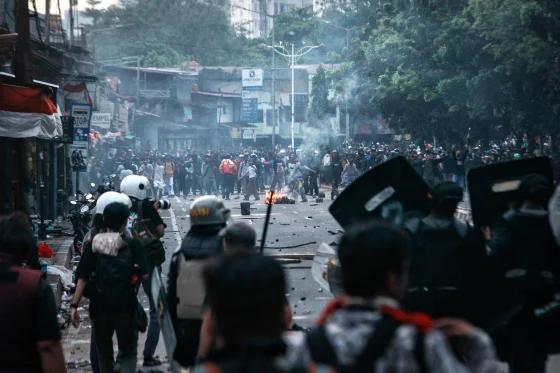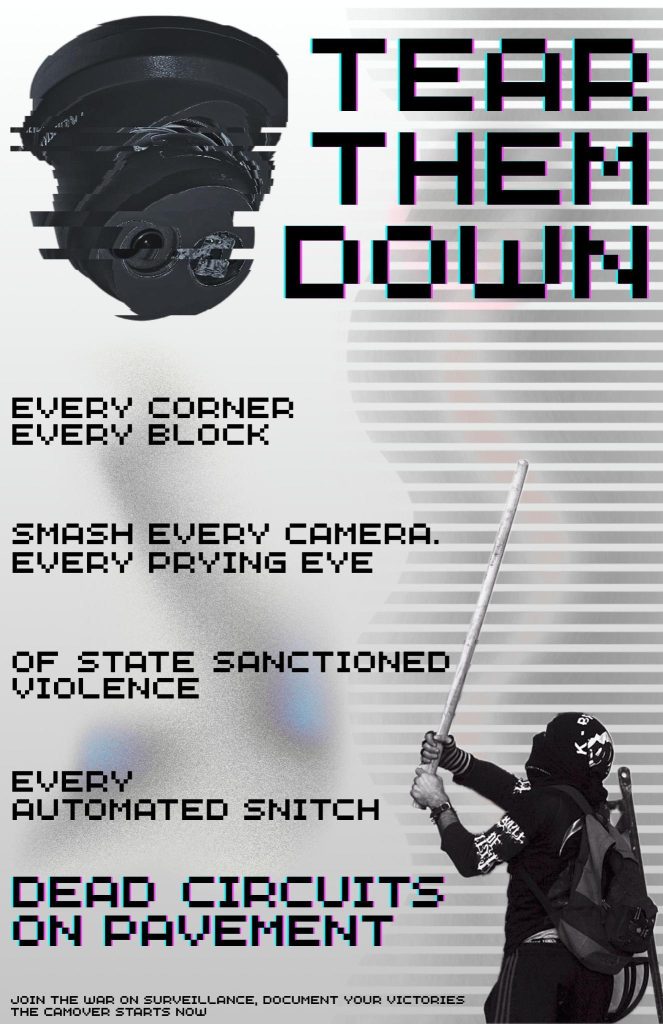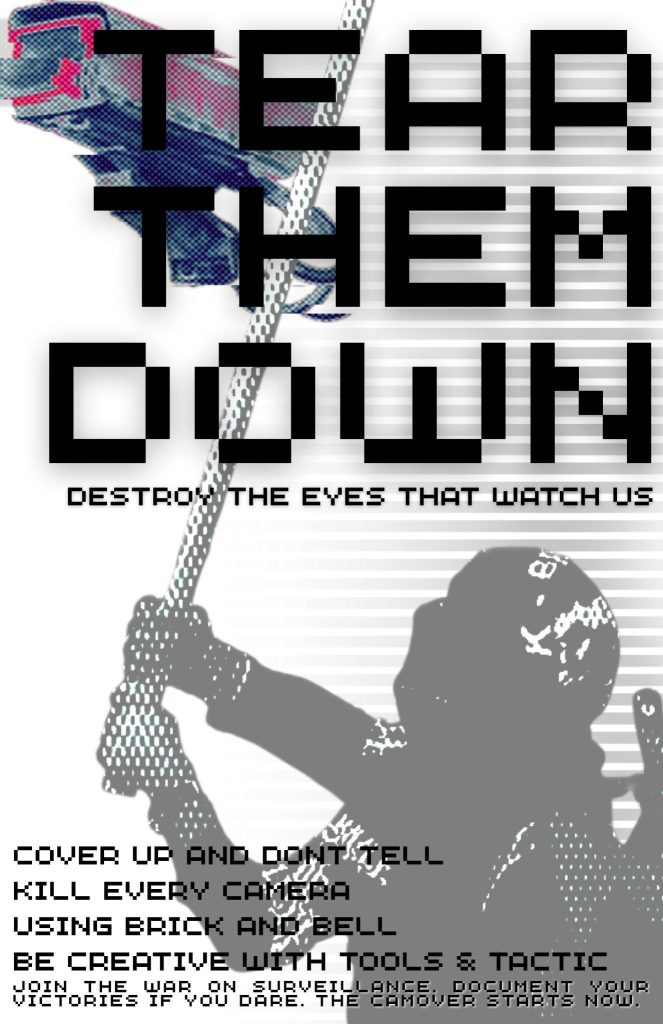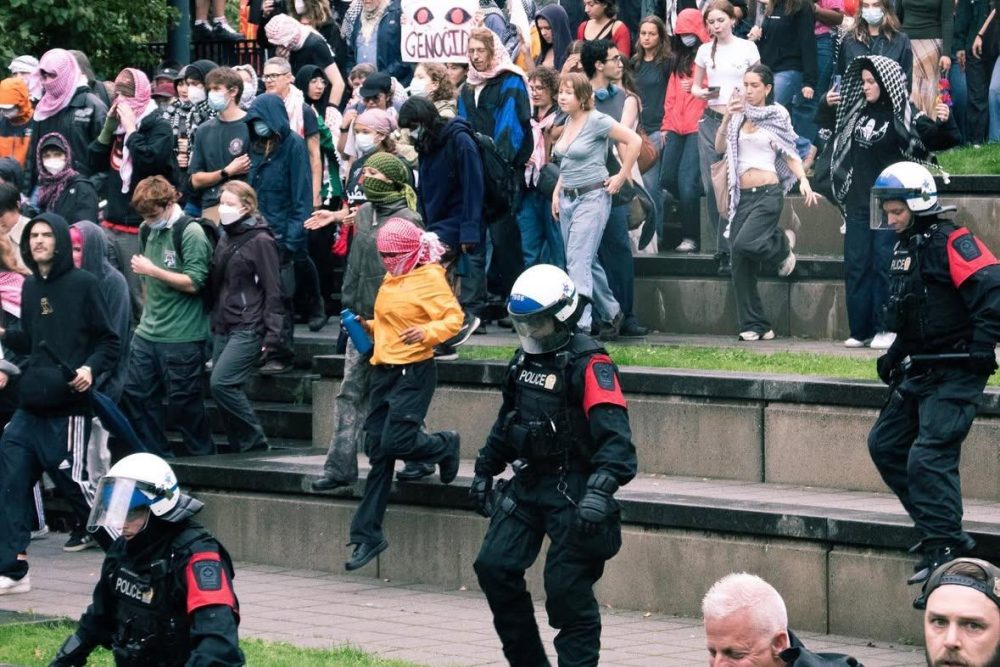From Dark Nights
This is from a talk by Toby at the Bristol Tattoo Circus, which took place a few weeks ago at a squatted venue in the city. After the talks and workshops there was bands, DJs and a benefit party. Free the prisoners!
Hello everyone,
Ok, we’re at Tattoo circus, my name is Toby Shone, I’m an ex-prisoner and anarchist. Tattoo Circus was started around 20 years ago in Italy as a way to fund anarchist prisoner solidarity campaigns.
I want to thank the organisers for inviting me here to speak, it’s very important as a released political prisoner to be able to come back into the community. Especially after living for a considerable amount of time distanced from the social movement. So overall, I want to communicate any lessons that can be told. Some of you already know me, so I’ll try not to bore you with what you know already, but for others I’ll just re-cap the case that I was involved in, then I’m going to simply give some anecdotes about my time in prison, and then speak about solidarity briefly.
I was arrested in the November 2020 Operation Adream case, and I was imprisoned for three years in conditions of solitary confinement and monitored for a year in line with UK-wide anti-terrorist restrictions by the National Security Division and Counter-Terror Police. From the evidence I’ve seen, it indicates that there is an ongoing investigation by the anti-terrorist units into the social movement in the South West region, and we can conclude that it’s also taking place across the country. I think it is certainly not for us to have to justify our harmlessness, but to really think about what it is going to take, long-term, for the type of social changes we’re aiming for.
Operation Adream was aimed primarily at shutting down 325.nostate, which was an anarchist counter-information website publishing international news. Operation Adream also tried to shut down the paper distribution of 325 Magazine #12, which is an anarchist-insurrectionalist analysis of new technologies. Adream was supposed to conclude with locking up anyone involved with the administrative or editorial decisions, or those involved in distribution.
In the very least, from the case files we saw, British, Dutch and German counter-terrorist police were involved in the operation and a server located in Holland hosting dozens of anarchist and radical left websites [among them, MTL Counter-info] was seized. Tommy Weisbecker Haus, a collective house project in Berlin was threatened by German and British cops. The collective house is named after Tommy Weisbecker, who was a comrade of the radical left, an autonomen, who was murdered by German police when he was only 23 years old. Footprint Workers Co-Op in Leeds, who are a well-known printers co-op in the UK movement was also threatened by the police if they didn’t co-operate with any investigation. Operation Adream used broad strokes, and that’s what we have to prepare for.
A day after the commeration of the Students uprising in 1975, in Athens, Greece, November 17th , Operation Adream struck. The Operation was planned to take place on the day before, in a clearly symbolic move against the combative memory of our social and revolutionary compatriots in Greece. You see, this ridiculous operation wished to connect the dots between a social uprising fifty years ago, armed urban guerrillas, some of whom are still in prison, and what is taking place in the Forest of Dean and Bristol.
The case would be absurd if it was not so dangerous as an instrument by the police to achieve their ends, but we have to understand what connects this. The very same kind of frame-ups of anarchists has been taking place in Europe and Latin America for a considerable amount of time. This is just the first time they apply it in UK, since the British cops seemed to have learned from their colleagues in Italy, Spain and Greece. In that, the police construct a fake anarchist organisation, or they subvert the name of an existing one, then they ascribe roles and functions that suit their hypothesis, this can change over time, but in the short term it justifies an enhanced budget, more man-power, extra-judicial powers, long periods of detention before trial, conditions of isolation and of being incommunicado, restriction of access to lawyers, visits, and so on. My sentence start point, if I had been found guilty, was around 18 years, with social controls basically for the rest of my life.
In the UK, Adream resulted in five addresses in the Forest of Dean being raided, three of which were collective house projects. This resulted in comrades and friends becoming homeless, losing their possessions, and in some cases, being harrassed by cops, interrogated at airports and intimidated at home.
In February 2021, I was charged with Section2. distribution of terrorist publications, which relates to the administration of the 325.nostate website; two counts of Section58. possession of information likely to useful for the purposes of terrorism, namely two videos, one of which demonstrated how to fabricate an improvised explosive charge, and the other, how to burn down a telecommunications tower. Lastly I was charged with Section15. funding terrorism, aggravated by the use of cryptocurrencies, which related to eletronic wallets used for supporting political prisoners and publications.
I was accused, but not charged with an incendiary attack against a police vehicle storage depo in Bristol, as part of the Phoenix Project, which was an international campaign of solidarity and destruction, dedicated to our imprisoned anarchist comrades, and instigated by the Revolutionary Organisation – Conspiracy of Cells of Fire, or CCF. The CCF is a nihilist-individualist anarchist network based out of Greece.
The incendiary attack against the cops was claimed by the Rain Cell, of the Informal Anarchist Federation. This is a reference to the FAI communique, Rain & Fire. I was also accused of an arson attack against a mobilephone repeater, also in Bristol, which destroyed a Vodafone antenna, and was claimed by a joint cell of the Earth Liberation Front and the Informal Anarchist Federation. The group who were responsible declared that as part of their reasoning, they hit Vodafone because the company provides communication services to the police. I was also accused of the liberation of a Pheasant game bird enclosure in Gloucestershire as part of the Animal Liberation Front. And none of us need to have a reason to free animals and not hurt them, it’s evident.
In the raids which struck our circles in the Forest of Dean, I took responsibility for all the narcotics which were found. Two medical marijuana grows spread over two properties. Almost a thousand hits of high-purity LSD; 30+ grams of the mega-tonnage hallucinogen, DMT; A third of a kilo of dried Psilocybin mushrooms; Hundreds of grams of THC oil; MDMA, Syrian Rue and other ingredients for Ayahuasca.
On that November 18th 2020, I was driving away from one of the houses when I was engaged by several unmarked vehicles of the anti-terrorist unit, and I attempted to get away in my SUV. There followed a carchase through the Forest of Dean.
It became clear that I could not outrun them without a serious risk of heavy injury or death to myself or others. Since I did not want to be caught out without witnesses and be beaten or shot to death, I found a populated area with civilians, where I attempted to decamp my vehicle, but I was apprehended by the plainclothes armed tactical unit that was pursuing me immediately. After some of the usual hazing on the floor with their rifles pointed at my head and chest, I was taken to Gloucester police station under an armed escort.
I was interrogated many times but I never gave any response. I did not co-operate.
Whilst imprisoned, my sense of self and determination was partly formed by understanding the struggles of those who have come before me. When we understand our history, we understand what we are capable of.
If we are serious about making social change and we want to make a revolution, then we have to be aware of the consequences. That is why it is important to support our prisoners.
Like imprisoned comrades Mumia Abu-Jamal, who is serving a death sentence-communted to life-imprisonment in the USA, framed for the murder of a cop; Daniele Klette in Germany, accused of membership of the Red Army Faction and of carrying out bank robberies; Alfredo Cospito, Anna Benniamino, Juan Sorroche Fernandez, all in Italy, accused of explosive attacks against the state, along with other crimes, and also serving very long sentences; Christos Rodopoulos, member of the Conspiracy of Cells of Fire in Greece, accused of triple homicide attempts after being convicted of sending parcel bombs to senior state officials and of planning the break out of imprisoned members of CCF; Marius Mason, imprisoned member of the Earth Liberation Front in USA, sentenced to 20 years and due for release soon for the arson of a bioengineering lab which was experimenting with gentically modified trees.
The last time I spoke at a Tattoo Circus event, was in Rome in 2024. I was locked up at the time at HMP Garth, which is part of the Long-Term High Security Estate. The topic in Rome that year was about the suppression of radical publishing, since many comrades in Europe face similar cases to the repression against 325. I made the presentation by telephone from my cell, and I was punished afterwards by the screws. As well as being cut in the number of visits I could receive, the time I spent out of my cell and the money I could spend on the canteen, I was banned from speaking to my comrade from Turin, and she was banned from visiting me, on grounds of National Security. I couldn’t speak with her for the remainder of my sentence. Evidently from the paperwork I was notified with at time, both of us were considered a risk to national security, which is an honour for anarchists. So, I appreciate the ability to speak today, and as the Tattoo Circus has a special focus on prisoner solidarity and the anti-prison struggle, that’s why I’m here, simply to give my experience in the prisons and some anecdotes and reflections. It’s not very complex.
The conditions in the British prisons today are nothing more than disastrous. Decades of neglect and cuts, without any real oversight or adherance to anything resembling consensus reality, have produced a literally crumbling and weakened regime of human warehousing and suffering. After the COVID-19 lockdowns, rountine 23 hour lockdown is normalised. Education and courses have been slashed, food budgets are minimal. Access to Gym and Library often barely functioning for the majority of the prisoners. Most guys are locked two in a cell made for one. Over 88,000 prisoners and a quarter of a million on probation. Overwhelmingly proletarian or underclass. Prison has a clear racial and class function and this is reflected in the prison population.
The crisis in the British prison system is one of overcrowding, violence, self-harm and drugs. Even as an ex-prisoner, or especially as an ex-prisoner, I find it hard to accurately relate the situation in the prisons and the harmfulness of incarceration. This is because most people just can’t comprehend just how bad the situation is, they either have no reference point, or they have no values to identify why the prison structure is not a solution for social problems, and which instead magnifies and upholds those self-same problems. I am not here though, to give you a litany of misery that you cannot alter, I’m here to say that all of you could find the sense of strength and will to survive, and with our solidarity networks, we can not only overcome the isolation, but we can tear the prison walls down.
As I was trafficked from the London Westminster Magistrates Court in February 2021, where I had my first pre-trial premilinary hearding, -since all terrorist cases are held here on their initial appearance,- the private security company driver pumped out pop reggaeton. He drove like a crazy lunatic with his cargo of captured criminals, all being dropped off at HMP Wandsworth. I had just narrowly escaped being transferred to HMP Belmarsh, London’s Maximum Security Prison, due to the Belmarsh prison transport being late, meaning I was about to spend 9 months before trial on remand in solitary confinement in the same Victorian prison as Oscar Wilde.
I was to find out nothing much had changed since his day, the cell I was held in was no better than a subterreanian dungeon, and it would be 4 months before I even saw my lawyers. 6 months before I saw the case against me. 6 months before I could see my comrades and partner. I was only able to go outside on the yard once every three weeks for 40 minutes or so for the entirety of that 9 months remand. I had no access to Gym, Education, Library, nothing. I regularly spent up to 48 hours without being able to leave my cell for more than 30 minutes. I was placed next to a new section of the prison being built, at the end of a wing next to the external door, which meant that my cell reverberated with high-volume construction noise everyday during work hours. This was a form of torture, which was a deliberate move by the prison’s anti-terrorist unit, who controlled where I was placed. It was intended to break my mind and will, and it failed.
During my time at Wandsworth, which is a disgusting trashcan of human waste and filth, accumulating for hundreds of years, there was at least one suicide per month. I was held on Trinity unit, a prison within the prison, alongside Russian, Ukrainian, Italian mafia, Postcode war knife kids and old school gangsters. With Islamic fundamentalists, Chinese fraudsters, high level banking money launderers and domestic killers. One night late, when silence was on the wing, I could hear a crisis on the adjacent wing on the triple-spur panopticon. It was the harrowing torment of a dying young Iranian man, who had taken a large overdose of Paracetamol. This is one of the worst ways to die, as your body goes into organ failure, shutting down piece by piece, whilst you’re completely alert and awake in excruciating pain. And no-one can save you once the time runs out. The prisoners in the adjacent cells were desperately trying to get help and ringing the cell’s emergency buzzers, but as anyone knows who has been in prison, there’s no-one coming, not anytime soon.
We listened to him die, it took hours.
You could hear his screams echoing around the prison walls, the cold Victorian walkways and vast empty arches silently bearing witness to another victim.
Afterwards, the guys howled like wolves and when the screws came, then the medical team, to take the body away, he became just another story from Wandsworth.
The next day, when I was out, I spoke with a young guy who was there on a money laundering charge, and he calmly told me how he’d advised the Iranian how he could kill himself, since the Iranian was depressed on account of the recent death of his mother. The Iranian man had been recently sentenced to two years but he was due for release in 10 months. It was senseless, but that is how bad the conditions are, and how cold the jail is.
In HMP Bristol, Horfield, the entire place is a disgusting hole of filth, with a total lack of resources. It’s run and managed by a small number of racist bigoted screws who do not have to answer to anyone really. One thing you learn when you enter prison is that the ‘laws’ and ‘rules’ and ‘rights’, that everyone believes are important, don’t mean a thing in prison, and they don’t mean a thing to the State. If you didn’t already know that, you’re in for a big shock inside. There is no real oversight, and if there was, it wouldn’t be for the benefit of the diginity and rights of the prisoners, that’s for sure.
In Bristol, I was told twice by a Senior Officer, Steven Sollars, that he could take me into the showers at anytime and murder me, and blame it on one of the other prisoners and get away with it, since there are no cameras, and who would believe me anyway? Solars made this boast in front of other prisoners, that’s how confident he was of his position. Senior Officer Steven Sollars, ex-military, tank regiment, late 50s, told me, that the Irish, were the same as the Taliban, they hide AK47s in their homes, fight in civilian attire and make dirty surprise attacks on the noble British soldiers. He didn’t know I’m from Irish descent, but he knew enough that in the run up to the Bloody Sunday rememberance, Solars insisted on baiting me, justifying the murders of unarmed civil rights protestors and civilians. At the time the inquiry into the murders had placed charges on former serving soliders, which have been recently been dismissed at court. This screw was a flag waving far-right past-it footy hooligan who boasted about attending far-right events and counter-protests in Bristol, you folks may even have gone up against him during all the recent demos.
These are the people we’re fighting. We have to take it seriously. Sollars loved making the statement that prisoners should be worked in chain gangs, that the screws should have guns and prisoners should be shot in the face with a shotgun if they rebelled. That’s what he thought about the folks who put the Colston statue in the harbour and the Black Lives Matter protestors, about the anti-war demos, the feminists, the marginalized. Just kill them all if they didn’t do what they were told. That this guy was working in this position should tell you everything you need to know about the prison service.
Naturally, I can’t tolerate such fascist bullshit and would repeatedly mock and abuse this miscreant, and several of us prisoners formed an anti-racist committee on G Wing. This screw coward cited me for ‘threatening staff’ after his feelings got hurt and I was put on cell lockdown for 10 days. Sollars was also blubbing because his details had been circulated on the internet along with a report of the situation, which got picked up by the Bristol Post. As prisoners, we also officially complained about the situation to the so-called appropriate authorities, but we might have as well put our complaints in the dustbin.
After that, Sollars used all the contacts he could to try to escalate my security level, and I was regularly referred to Category A consideration boards after that. I was ghosted not long after under high-security and banned from HMP Bristol by the outgoing governor, who was later to get transferred himself, since Bristol prison was put under special measures and condemned by Charlie Taylor, the Chief Inspector of Prisons. Not that that made any difference whatsoever.
The second time I was in Bristol prison, just after I had been snatched by armed cops and recalled by the National Security Division, anarchist comrades made a firework demo at the prison, and shot them low over the jail. They exploded right above the yard near where my cell was, at the back of the prison complex. That’s where new prisoners and high-security are held. The rockets exploded just above the third floor windows. I was chilling on my bunk watching TV in the dark, I’d got up and was looking out. The explosion made me duck my head, it was like a bomb went off.
I was so shocked, and surprised, and I knew it was anarchists. I started shouting out of the window, ‘Fire to the prisons’, and ‘The passion for freedom is stronger than prison’, ‘Fuck the system’, ‘Fuck the screws, Fuck the police’, ‘Death to the king, Death to the state’. It made me very strong, that demo.
The imprisoned guys were active now at the windows and I could hear the demo outside the walls.
We all looked down on to an empty exercise yard, and with the fireworks above, the prison stirred.
A screw came to my door, a sister in a hijab and HMP uniform. She looked at me quizzically through the slot in the door, and then rolled her eyes, indicating it was futile. I shook my head at her and laughed, she closed the observation hatch. Next door, some coward snitch started sobbing, ‘It was him, miss, he started it, he was screaming and shouting about fuck the governor’. I called for him to shut the fuck up and the other lads joined in. We could barely hear the demo really from where we were, but the rockets had struck at exactly the right place to kick it off.
I didn’t get any immediate official retaliation but the regime was clearly irritated. The National Security Division, Secretary of State and Prison Service decided to ghost me again, this time to the Long-Term High Security Estate at the other end of the country, far away from the South West.
I was happy about that at the time, because in Bristol I was held in a cell with blood all over the walls where someone had cut up in there and there was a total lack of resources. There were not enough plates, spoons, forks and basic essentials, like in many of the other prisons I’d been in. Garth on the other hand, has microwaves and hot plates to cook food on, and as a long-term prison, it has a better sense of solidarity between the prisoners. Bristol is a remand prison, so it’s got a high number of people passing through on short sentences. But it’s also homely. I like coming in on the prison transfer bus knowing that the anarchists here are going to give the screws and the police something to write a report about. I always got good visits here too, despite the fact HMP Bristol is a particularly bad place to visit.
Often when we guys are queuing up for visits in Bristol prison, the screws there are mocking us, and trying to disrupt our sense of self before we see our loved ones and friends. We have to get searched before we go in by a team of screws, some of us get strip searched. We get placed in two seperate windowless anti-chamber rooms with hidden microphones and CCTV, and we have to present our IDs. On the way out of the visit we have to do the same, and the screws try to shake us down from the high we’re on from seeing our people. Just to see you rattle, they’ll try to put it on you. It’s just pathetic. If you are weak in prison, you have to watch out.
When I was in Wandsworth there was a young guy, early twenties. The majority of the guys there were supposed to have prison jobs or were studying. At least, that was the theory, but generally the unit was just another dumping ground, and because of COVID-19 there was no functional regime. This kid was autistic, and he was struggling with being in prison and in a single cell, since he was vulnerable. The screws gave him a job cleaning the floors, and he used to listen to a little wind-up radio set and mop the floors of two of the wings of Trinity. I used to check for him because he was clearly not okay. We used to talk about TV programs, he liked the Big Bang Theory, which I don’t know anything about, but he would explain it to me. He was not coping and spent a lot of time crying, even though he was only looking at a possible 4 year sentence. The screws had put him in a single cell in a basement wing with no sunlight. The walls of the cell were painted black by some previous junky. Nobody else would put up with being in there, it was a hellish cell covered in insane graffitti. It was despicable seeing this young autisitic kid being held like this but there was little I could do about it.
One late afternoon, I was out of my cell with a few other guys who were cleaners. We could see some commotion at the central panopticon hub of the wings at the centre of Trinity. In the middle of the ring was this autisitic kid, and he was being beaten and stamped on and twisted up by at least 8 different screws. It reminded me of when I’ve seen police do it to protestors during arrests or later at the cop station. There’s no real method to it, and here there was no restraint, it was behind closed doors, and it was therefore justifiable.
There was no sense to it. They each just took their turn beating and bending this kid in whatever blows and holds they felt like. It was horrific. There was the metal gates separating us prisoners and the scene we were watching, we could not intervene. We called out for them to stop, that they were bastards, that he was only a kid, and that he was autistic. More screws came and they continued to maul this kid around the centre of floor like a pack of dogs. Male and female screws alike. They dragged him along the floor, and stood and kneeled on his knees, his legs and arms, his back, twisted his wrists and neck, his ankles, and struck him with blows from above and to his sides.
By this time, we prisoners were really angry, and we realised that there is a bastard in uniform caught on our side of the gates, but unfortunately, it is Mo, who is a low ranking screw and not a too bad guy. This guy was one of the few who was okay, but he has no power. Mo calls out to the other screws to stop before they kill the poor kid, as more screws arrive, flooding the Trinity hub and dragging the kid to his cell, battered and bloody, as we are put back in our cells by force.
The next day I heard through my door what had happened to trigger such an assault: the autistic kid had been mopping the floor of the adjacent wing and the screws wanted him to stop and bring his radio back. The kid wanted to sit with his radio on a table after he finished his work for 10 minutes but that was not permitted. He resisted moving and they attacked him.
In G4S Parc, I witnessed a principled father of three kids who was in for a drugs and fraud charge repeatedly resist the screws over infractions against his dignity, including so-called incidents at height where he would climb to the highest point he could in expressions of strength and will power that are almost absurd. This guy was previously described as a hero in his local newspaper for saving a family who were in a house fire.
In G4S Parc, many of the men did not have glass in their cell windows, the windows did not have glass or perspex in them. You may think I’m making it up but you don’t understand what is taking place there. I’d go out onto the yard and out of, say approximately, 27 x 27 windows of 3 x 9 rows, there were a dozen windows put out in each separate wing overlooking the yard and never repaired. The men in there were freezing, they had to choose between putting up their matresses against the bare cold or on the metal frame cot and having the seasons and the night pouring in between bars.
I was there for over a year and there were never any repairs. It was depraved. I complained officially and got nowhere. Who cares about the men who are criminals? I asked one of the screws, and he said that in all the time he’d been working there, it had always been like that. Imagine that, in the winter weather, near the South Wales coast. Imagine being stuck in that cell, 23 hours a day, without enough food, enough clothes and bedding, addicted to Spice, well that’s the reality for lots of those guys over there in G4S Parc, a private prison run by the G4S security company. When I was there, the Spice epidemic was totally out of control, and since I left, I heard there were many deaths, and also riots. After she had won an award for her outstanding achievements at Parc, the governor, Janet Wallsgrove, was transferred. And so it goes on.
In G4S Parc, I made a symbolic rolling hungerstrike in solidarity with Alfredo Cospito when he was hungerstriking. Also with Ivan Alocca, Juan Sorroche Fernandez and Anna Beniamino, who were also imprisoned. Only Ivan is free now. Ivan was accused of several car arsons of luxury and corporate vehicles in solidarity with international anarchist prisoners. Naturally I felt an affinity with him, because this is the really meaningful revolutionary solidarity, when the comrades put themselves on the line, when they risk their lives for what they believe in.
Ivan is now free but the other comrades are still imprisoned, Alfredo Cospito is still placed in the 41bis isolation units and needs long term support, similar to other imprisoned comrades I’ve mentioned. All these comrades are sentenced for serious direct actions against the state and heirarchy. Alfredo is sentenced for the non-fatal shooting of Ansaldo Nucleare CEO Roberto Adinolfi and several non-fatal explosive attacks. Anna and Juan are also sentenced for explosive attacks and are serving the equivalent of life sentences.
The hungerstrike campaign was supported by an international mobilisation and direct actions from the outside. Since I do not have the build or health to survive such a serious hungerstrike for very long, and since I was at that point earlier on in my recovery from cancer, I chose, after talking to my close ones and friends, to make a rolling hungerstrike, choosing three days a week to refuse to eat. It was a minimal gesture I could make for the campaign. Personally, I am very wary about hungerstrikes as we know they depend on the enemy, the regime conceeding as we die. Right now there is one taking place by the Palestine solidarity prisoners. Hungerstrikes require a lot of support and solidarity. Here in UK, the State has a no compromise approach to such political negotiations, and when they enter into them they are a deception and only a method to destroy the opponent. We see how the British State dealt with the hungerstrike of the Irish republicans, and of the animal liberationist Barry Horne, who died on hungerstrike.
During Alfredo’s hungerstrike, a few of us prisoners wrote slogans in support of the social war and in support of Alfredo and Anna, on our yard, with permanent markers we’d stolen from the screws. Such a small gesture, and when I told my Italian comrades on the phone they were overjoyed, still.
When a surprise anarchist demo happened at G4S Parc on my birthday, it timed surprisingly perfectly to coincide with the shift change for staff at the later part of the day. As a result dozens of staff couldn’t leave the buidling and the youth wings and segregation units kicked off. At the back of the prison complex in high-security again, I watched the fireworks light up the sky and listened to the laughter out of my cell window. I chatted to my friend next door out the window and we enjoyed the show.
Next day, I was out on my yard time and I’d stopped by some friends who were playing monoply, a posse of screws turned up and forced me off to go to segregation, strip searching me, scanning me through an Xray machine, passive wave millimetre. They took my clothes off me and forced me into a grey tracksuit whilst verbally abusing me. I did not bow my head and I maintained my hostile stance. The chief of the security in the prison came and asked me what I thought I was doing, and I said I had no idea, and that I didn’t know what he was talking about, laughing.
When I was released on probation at my half-way point from G4S Parc, I’d pissed off the security department and prison administration so much that my cell was raided and searched at 5 am on the morning I was due to be released. A dozen screws kicked the door in and flooded my cell, ripped apart my packed bags of possessions and rifled through them. They dragged me out of bed naked, then they made me get dressed, before strip searching me again, giving me their threats and abuse that they were going to hunt me down on the outside. I laughed at them and mocked them childishly. They’d come to escort me at that time early in the morning so that none of the other prisoners would see me leave, and I couldn’t say anything to anyone. Of course I suspected they’d pull some stunt like this and had prepared accordingly. The screws forced me to a secure holding chamber and the counter-terrorist police were waiting to take me to the open unit in Gloucester. I cracked some jokes and said goodbye, safe in the knowledge I’d bruised some egos and upset the bigwigs.
Whilst what I saw in prison really was the most useless waste of money, time, energy and resources imaginable, it was also proof to me that the State is presently weak enough that we could deliver serious blows and liberations, if we had a social movement that was committed enough to those aims. What we need is an underground orientated movement, which develops a structure of decentralised safehouses and that carries out revolutionary actions against the system.
Our social movement, if it could actually get its act together, has the potential to be a real threat to the British regime, and modern authoritarian regimes everywhere. At the moment we are facing a huge far-right expansion but it is really only the work of the mainstream politicians of the last 30 years. There are going to be new shifts in power, and the social contract that signified the general post-WWII consensus has been lost, but this means the possibilities for revolutionary action are more accute and needed than ever before.
I grew up in a time when the armed struggle and anarchist revolutionary violence was closer, I lived through times of the large counter-summit mobilisations and city-wide destablising riots in Europe. I have been in the action groups and the discussions, and I’ve seen my friends disappear into the mouth of the abyss. At the moment there is an asymetric state of war in Europe and we have just witnessed a genocide of the Palestinian people.
However, all over the world, we’re connecting our struggles in new ways, and we’re seeing the anti-authoritarian and anarchist methods and ideas spreading, especially where the State is weak, top-heavy or fractured due to its outdated nature. We are looking at a networked, horizontal future, as the system further breaks down and the ecology collapses. The infrastructure that we build today is going to take part in the social conflicts of tomorrow.
We should support all the anti-repression groups like the Anarchist Black Cross, Bristol Defendant Solidarity, the Anarchist Defence Fund, all the letter-writing groups and benefit events, organised by all the unsung heroes doing all the work to support our imprisoned comrades.
Thank you everyone for listening to my prison anecdotes and my ramblings, take care of each other, destroy the prisons, and destroy the state.









